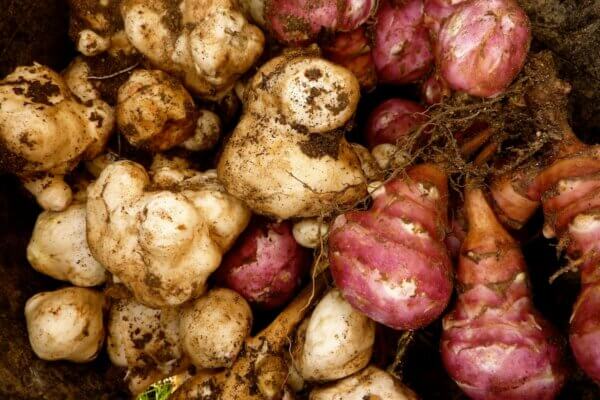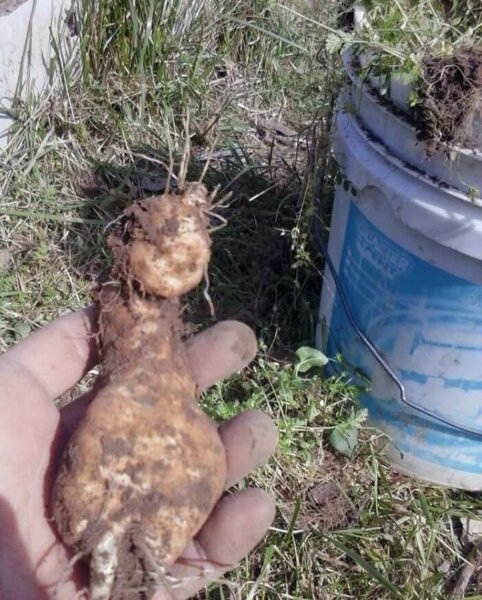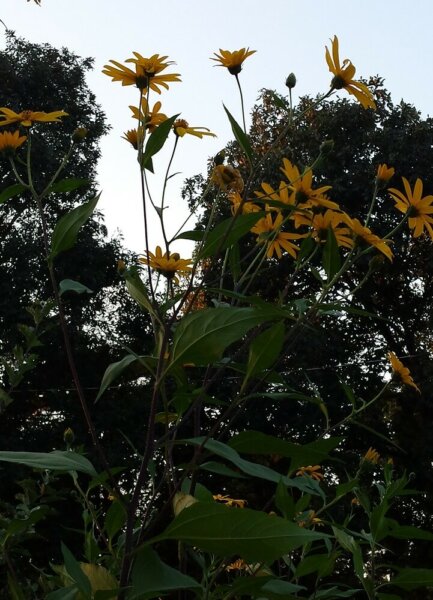I first discovered Jerusalem artichokes about four years ago in Arkansas. I thought my eyes were playing tricks on me when I saw the 5-foot stalk with a yellow flower that looked like a miniature sunflower without the seeds. I flipped through my edible plants book, surfed the web, did some research and was pleased to find out I stumbled across a tasty wild food.
So, What’s A Jerusalem Artichoke?
Jerusalem artichokes (Helianthus tuberosus) are a variety of sunflower with an edible root that looks similar to the ginger root. The stalks of the flowers can grow over 10 feet tall and are easy to spot once you know what you’re looking for.
Related Post: How Sunflowers Follow The Sun
The yellow flowers look so much like a tiny version of a sunflower without seeds! The Jerusalem artichoke is known by many names, a few of them being earth apple, sunchoke, and sunroot.

There are a few different species of the Jerusalem artichoke variety of sunflower. Not all of the tubers look the same or taste the same, although the taste is somewhat similar. The sunchokes I found in Arkansas resembled ginger with thicker and bumpier skin.
The little, lumpy brown-skinned tubers have white flesh on the inside. Don’t be fooled, this root/tuber is not an artichoke by any means, nor is there any relation to Jerusalem.
Habitat & Harvesting
Jerusalem artichokes can grow almost anywhere. They really love well-drained soil that contains a lot of organic matter. These amazing tubers are actually known to be somewhat of an invasive species, so they spawn and take over rather quickly.
Fields, meadows, prairies, along railroads, and forest lines are all places I have seen the chokes growing. As long as there is good soil and full sun this plant will thrive.

You’re going to want to mark your plants when the flowers are in bloom so you can return to harvest them when the flower and stalk die back. The harvest takes place during late autumn and into winter. You can dig them up with a garden fork or a shovel, either one works just fine, although I prefer to use a garden fork because it does less damage to the roots.
Growing
You can choose to let your Jerusalem artichokes grow wild and forage them as they appear, or you can save some of the tubers and plant a sunchoke garden. These plants do most of the work for you.
Related Post: 15 Seeds You Should Save
Plant your tuber in full sun in a spot with well-drained soil for the best results. They don’t require much watering or weeding, and it’s best to plant the tubers at least 4-6 inches into the ground and about a foot apart from each other. Giving the tubers at least a foot of space between one another allows the future roots to grow larger.

You can plant your Jerusalem artichoke tubers straight into the ground and let the magic take place. One thing I really love about the Jerusalem artichoke is that you can grow them in tubs for small-space gardening. If you have some space near a window that gets lots of sun, you can even grow the chokes indoors.
Jerusalem Artichoke Varieties
Not all of the species of Jerusalem artichokes look the same. There are red varieties, white varieties and a yellow variety. The only Jerusalem artichoke that gets an actual flower is the flowering Helianthus tuberosus, which is the variety I found while foraging.

Within the different varieties, there are red and white strains. The red strains consist of ‘Red Fuseau’, ‘Waldspine’, and ‘Red Rover’. The white strains consist of ‘White Fuseau’, ‘Flowering Helianthus Tuberosus’, ‘Stampede’ and ‘Clearwater’.
Different Varieties
- Red Fuseau
- Stampede
- White Fuseau
- Red Rover
- Flowering Helianthus Tuberosus
- Waldspine
- Clearwater
Some Problems With The Jerusalem Artichoke
So far, all of the information I’ve shared about the Jerusalem artichoke has been good. Now I’m going to share some of the potential problems. No worries, they’re pretty simple to fix if you want to take the time.
- Slugs and snails feed on the young seedlings.
- The plants can become infected with sclerotinia, a fungal disease. The disease causes the plants to rot at the base, and white fluffy mold grows in the affected areas.
- The chokes can be somewhat of an invasive species, and they come back every year multiplying in number. If you don’t want them returning after a harvest, you have to be sure that you remove all of the root tubers.
Preparing, Cooking, & Eating
Any variety of choke is best eaten freshly picked. Peeling artichokes can be a chore, the more knobs the choke has the harder it will be to peel. The skin is OK to eat, but it changes the flavor of the vegetable a significant amount.
You can cook a Jerusalem artichoke just like you would a potato or parsnip. They are delicious roasted, sauteed, as well as battered and deep fried. They do well in soups, stews and can make pretty tasty chips too!
Jerusalem artichokes are not only a super staple food but they are also fit for fine cuisine. One of my favorite chefs, Guy Fieri, uses sunchokes in a pasta salad. The Fieri Farfalle Salad is Guy’s specialty salad that he makes using mozzarella, red bell pepper, pesto sauce, olives and Jerusalem artichokes. He also makes a sunchoke & split pea soup topped with goat cheese croutons and crispy pancetta.
Jerusalem artichokes have been utilized and enjoyed for many centuries. I’m not sure why they don’t have them in more grocery stores! They are a great addition to your kitchen if you’re into the flavor.
I am still trying and learning new ways to use these roots in my cooking. Have you ever tried Jerusalem artichokes? If so, how did you choose to prepare them, and how did you like it? Something interesting about the chokes before I go is that they have been looked into as a possible fuel, and people have been making spirits with them for many years too!










































Ah yes, i remember these very well as my father used to grow rows of them in the wonderfully fertile back garden soil of Nuneaton, Warwickshire. Just lately the supermarket chains, Sainsbury and Waitrose have stared selling them. A word of warning : these things ought to be called ‘fartichokes’ because they produce bed sheet lifting bowel gas !
I want to find tuber of different varieties of jerusalem hartichoke. Where can i Find?
To reduce the gas-producing effect, boil it in an acidic bath. Maybe lemon juice, a teaspoon of vinegar – something like that…